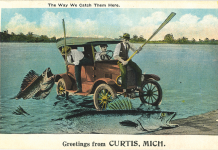
Michigan’s tourist industry is too often taken for granted. Michigan wasn’t always the vacationers’ paradise it is today. Cutover lands, difficult transportation and sparse accommodations left much room for improvement. Although the state boasted beautiful lakes and rivers, sand dunes and forests, and recreational opportunities, there was no concerted effort to boost the tourist advantages of the state.
The growth of tourism in Michigan began with the West Michigan Tourist Association 100 years ago. Founded in Grand Rapids in 1917 as the Michigan Tourist and Resort Association, it was later renamed the West Michigan Tourist Association (WMTA). Established as a nonprofit association, it was the first grass-roots tourist organization in the country. Hugh J. Gray was hired as its leader, and his vision propelled unprecedented economic growth for the tourist industry in West Michigan.

As one of his first efforts to attract visitors to the region, Gray advertised in 33 Midwestern and southern newspapers in seven states. WMTA’s earliest promotional brochures and maps were published in the teens, followed by annual vacation directories in the 1920s and early 1930s. The booklets featured three-color maps of each county, showed main highways, railroad lines and steamship routes. It included listings of hotels, inns, resorts, campgrounds, golf courses and garages. By 1936, the directories evolved into the annual Carefree Days in West Michigan, which continue today.
Over the next decades, WMTA published fishing, hunting, canoeing and other specialized guides. Winter sports guides in the 1950s and 1960s helped boost Michigan’s ski and snowmobile industry. The 1970s and 1980s provided guides to dining, shopping, golf, lighthouses, outdoor life and more. The first Lake Michigan Circle Tour guide was published in 1988. A new record was set in 1990 with 475,000 pieces of tourist literature printed and distributed.
The organization encouraged the creation of local festivals, pageants, tournaments and regattas, many of which still are going strong today.
Besides publications, WMTA found other means of promotion and publicity. In 1927, WMTA conducted the first tour for travel writers from Midwestern newspapers. It highlighted attractions in West Michigan and considerable free publicity resulted from the four-day excursion. Other states soon adopted the idea. Much of WMTA’s work was copied in other parts of the state, and three other regional tourist associations were formed to promote their specific regions.
 In 1929, Hugh Gray worked with the other regional tourist associations to secure the first state appropriations for tourist advertising, amounting to $100,000 per year for two years, to be divided equally among the four groups.
In 1929, Hugh Gray worked with the other regional tourist associations to secure the first state appropriations for tourist advertising, amounting to $100,000 per year for two years, to be divided equally among the four groups.
WMTA also originated the idea of out-of-state offices and, by the mid-1930s, had informational offices in Chicago, Detroit, Cleveland, Cincinnati and St. Louis. It sponsored radio shows in Chicago, publicity lectures in Florida and participated in regional outdoor and travel shows that had potential for drawing visitors to Michigan.
WMTA saw the value of the recreational opportunities West Michigan offered and the economic growth that would follow. It promoted the development of the state park system in the 1920s and the establishment of the Manistee National Forest in the 1930s. The organization encouraged the creation of local festivals, pageants, tournaments and regattas, many of which still are going strong today.
Know Michigan Week was organized in 1940 by the WMTA to spread the word in a publicity campaign, which successfully ran for two years but stopped as World War II progressed. The idea was resumed as Michigan Week in 1954. WMTA lent its political power to further causes, such as funding for historical markers, the returnable bottle referendum and the “Uniform Monday Holiday Act,” creating three-day weekends. With its strong history of boosterism, it continues its legacy today, promoting the tourist advantages of Pure Michigan.
BLUE Vintage Views columnists M. Christine Byron and Thomas R. Wilson reside in Grand Rapids. They are authors of the new book “Vintage Views Along Scenic M-22 including Sleeping Bear Dunes.”







Facebook Comments